 Java
Java
 javaTutorial
javaTutorial
 JAVA database-based automatic generation tool, JavaBean, database documentation
JAVA database-based automatic generation tool, JavaBean, database documentation
JAVA database-based automatic generation tool, JavaBean, database documentation
TableGo v5.0.0 version update is shockingly released, the function is more powerful, come and watch quickly, this version update is as follows:
1. The UI interface has been greatly revised, and the functional modules have been reorganized to meet the richer functions and designs in the future. .
2. Added Mapper mapping configuration files for batch generation of MyBaits.
3. Added the function of generating SQL based on database tables, which can automatically generate various SQL according to configuration.
4. Modify and optimize to quickly generate JavaBeans based on fields, add field types and default types, etc.
5. Fixed the issue where JPA annotations generated by PostgreSQL sometimes make errors.
6. Support database case-sensitive and table names and field names that contain both uppercase and lowercase letters.
7. Provide Jar package version, perfectly supporting Linux and MacBook.
8. Other bug modifications and code optimization adjustments.
There is another setting tip here, that is, when setting the entity generation strategy, it is best to choose no field validation, because I found that obtaining field validation data through JDBC is a bit slow and inefficient. Moreover, by configuring the naming strategy of Hibernate and MyBaits, the entity generation strategy can be set to "no Column annotations on all fields". This will generate JavaBeans the fastest and make future code maintenance much easier.
Hibernate or JPA Configuration: hibernate.ejb.naming_strategy = org.hibernate.cfg.improVEDNAMIMINGSTRATEGY
This configuration: MapundersCoreTocamelcase = TRUE (So after configuration, there is no need to write a resultMap field mapping in MAPPER.XML )
The database driver package used by MySQL: mysql-connector-java-5.1.39.jar
The database driver package used by Oracle: ojdbc14.jar
The database driver package used by SQL Server: sqljdbc4.jar
The database driver package used by PostgreSQL: postgresql-9.4.1212.jre7.jar
has been automatically generating JavaBeans according to the database table structure, automatically generating MyBaits Mapper mapping configuration files, and automatically generating databases. Designing documents is a headache, a waste of time and cumbersome. Looking at tens of thousands of fields in dozens or hundreds of tables is really painful.
We have also thought of many ways to solve this problem, including using MyEclipse to connect to the database to generate JavaBeans, but there are still some unsatisfactory aspects, including the fact that comments for tables and table fields cannot always be generated, and there will be A lot of useless comment code is generated, which makes the code look unclean at all, and the configuration is very cumbersome, etc.
So out of anger, I started to make enough food and clothing by myself, so I wrote an automated database-based generation tool using Swing, which supports four databases: MySQL, Oracle, SQLServce, and PostgreSQL, and supports multiple operating systems such as Window, Linux, and MacBook. The system perfectly supports JPA annotations, can generate Entities and DTOs at the same time, can automatically remove table prefixes, and supports single and batch generation of JavaBeans. Now not only can comments be generated on member variables, but there can also be comments on Getters and Setters. More importantly, it can also automatically generate database design documents and MyBaits Mapper mapping configuration files. If there are multiple data sources, it can also be generated in batches, which is very convenient to use.
All configurations are saved locally. As long as they are configured once, the Mapper mapping configuration files and database design documents for JavaBeans and MyBaits can be generated in seconds the next time you use it. It also integrates various practical tools to make work more efficient. Instantly explode, productivity instantly explodes!
After using and accumulating some projects, I will share it. If you have any good suggestions and ideas, you can also put forward them. Because I am very busy and do not have time to do very comprehensive testing, there must be some bugs. Due to environmental reasons, the main tests are MySQL, Oracle, SQLServer, and PostgreSQL are not fully tested, and there may be some bugs. If you find any bugs, remember to tell me so that they can be corrected in the next version.
1. Database configuration interface: 
2. Public parameter configuration interface: 
3. Generate Bean configuration interface: 
###4. Generate MyBaits Mapper mapping file configuration interface: 
5. Generate database design document configuration interface: 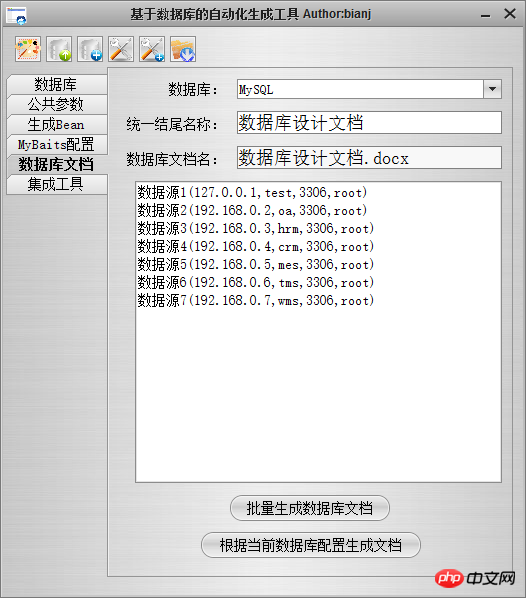
6. Integrated tool interface, Integrating 11 practical tools, work efficiency is instantly improved several times: 
7. Added the function of generating MyBaits Mapper mapping configuration file, and batch-generates Mapper.xml according to the current database configuration:


8. The function of batch generating database design documents can quickly generate databases in batches. Design documents. If a multi-thread processing timeout exception occurs when generating a document, you can avoid the timeout exception by increasing the multi-thread timeout and reducing the number of tables processed by each thread (modifying multi-thread parameters requires restarting the program). If the generated Word file If you can't open it with MS Office, you can open it with WPS and save it once, and then you can open it with MS Office. If you don't have WPS installed, you can also open it with WordPad, and then save it as a docx file. It is recommended to open or transfer it with WPS. , so that the file style will not be affected, and the ER diagram will be clearer. The Word file is generated with docx4j-3.3.1.jar: 
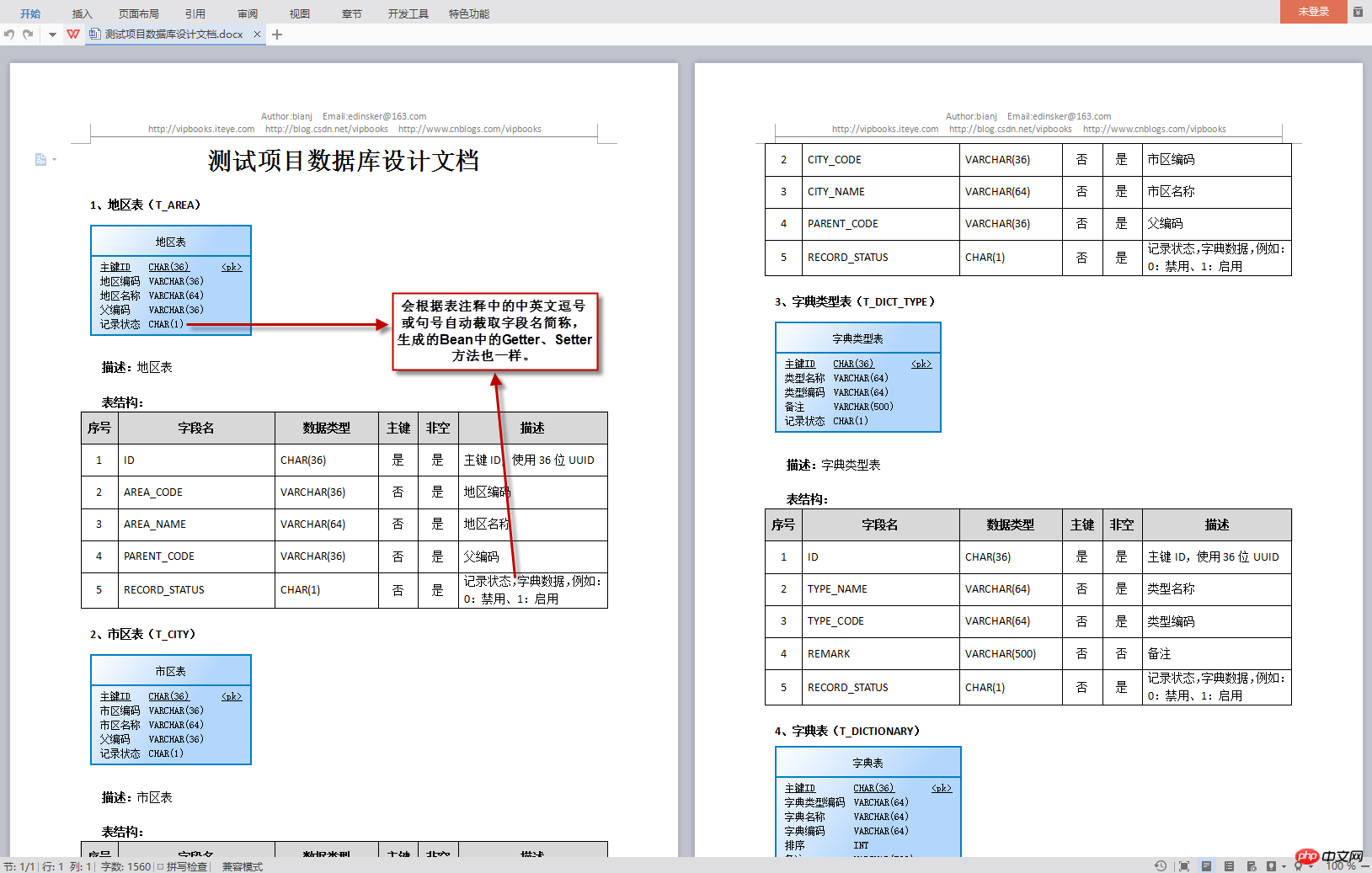
9. Modify and optimize to quickly generate JavaBeans based on fields, add field types and default types, etc.: 


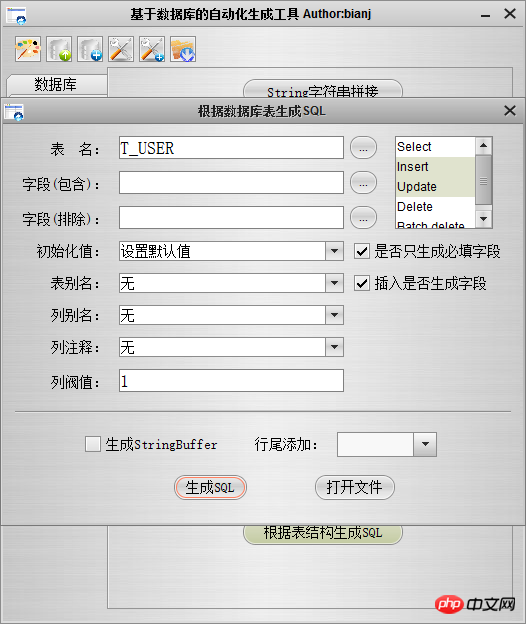

11. This is the automatically generated Entity and DTO: 
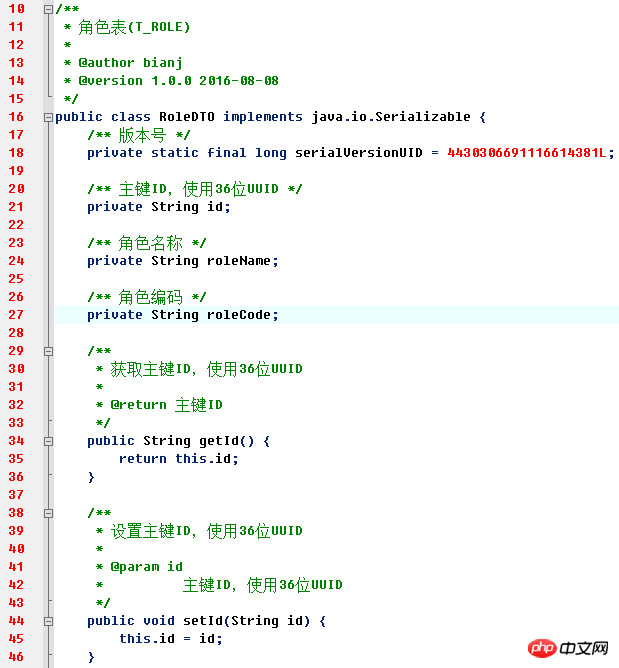
12. This The latest source code statistics: 
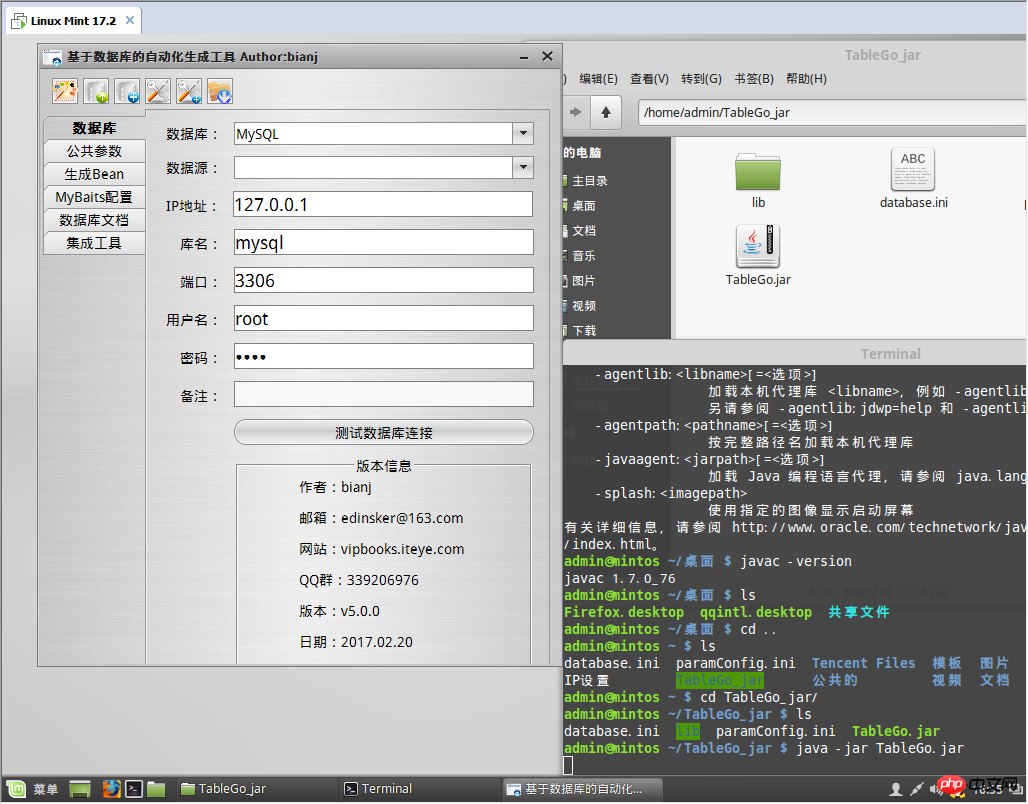


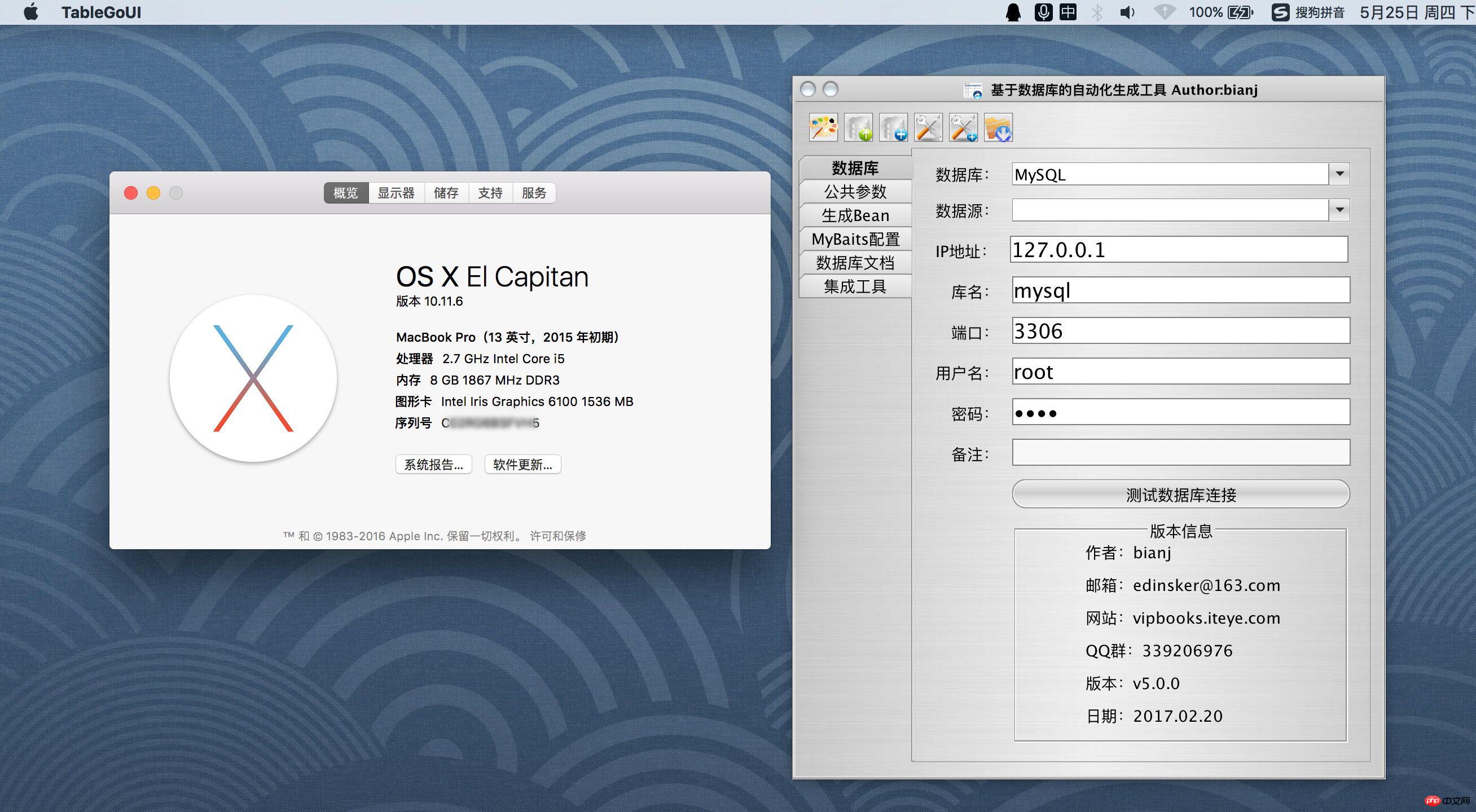
## To use this tool, you need to install JDK7 and above, because the development environment and compilation environment currently used are JDK7. Other versions of JDK have not been tested. There should be no problem with higher versions. They must be included in the environment variables of the operating system. Configure JAVA_HOME, otherwise Java will not be found.
I have looked for a lot of tools to package Jar packages into EXE files, but none of them can perfectly support 64-bit systems. Finally, I found exe4j, which can finally perfectly support packaging into a version supported by 64-bit systems. I myself I am using the 64-bit Win10 system that comes with Alienware15R2. If the generated 32-bit program cannot run, please tell me and I will go find a virtual machine to test it.
The above is the detailed content of JAVA database-based automatic generation tool, JavaBean, database documentation. For more information, please follow other related articles on the PHP Chinese website!

Hot AI Tools

Undresser.AI Undress
AI-powered app for creating realistic nude photos

AI Clothes Remover
Online AI tool for removing clothes from photos.

Undress AI Tool
Undress images for free

Clothoff.io
AI clothes remover

Video Face Swap
Swap faces in any video effortlessly with our completely free AI face swap tool!

Hot Article

Hot Tools

Notepad++7.3.1
Easy-to-use and free code editor

SublimeText3 Chinese version
Chinese version, very easy to use

Zend Studio 13.0.1
Powerful PHP integrated development environment

Dreamweaver CS6
Visual web development tools

SublimeText3 Mac version
God-level code editing software (SublimeText3)

Hot Topics
 1662
1662
 14
14
 1418
1418
 52
52
 1311
1311
 25
25
 1261
1261
 29
29
 1234
1234
 24
24
 How to understand DMA operations in C?
Apr 28, 2025 pm 10:09 PM
How to understand DMA operations in C?
Apr 28, 2025 pm 10:09 PM
DMA in C refers to DirectMemoryAccess, a direct memory access technology, allowing hardware devices to directly transmit data to memory without CPU intervention. 1) DMA operation is highly dependent on hardware devices and drivers, and the implementation method varies from system to system. 2) Direct access to memory may bring security risks, and the correctness and security of the code must be ensured. 3) DMA can improve performance, but improper use may lead to degradation of system performance. Through practice and learning, we can master the skills of using DMA and maximize its effectiveness in scenarios such as high-speed data transmission and real-time signal processing.
 How to use the chrono library in C?
Apr 28, 2025 pm 10:18 PM
How to use the chrono library in C?
Apr 28, 2025 pm 10:18 PM
Using the chrono library in C can allow you to control time and time intervals more accurately. Let's explore the charm of this library. C's chrono library is part of the standard library, which provides a modern way to deal with time and time intervals. For programmers who have suffered from time.h and ctime, chrono is undoubtedly a boon. It not only improves the readability and maintainability of the code, but also provides higher accuracy and flexibility. Let's start with the basics. The chrono library mainly includes the following key components: std::chrono::system_clock: represents the system clock, used to obtain the current time. std::chron
 How to measure thread performance in C?
Apr 28, 2025 pm 10:21 PM
How to measure thread performance in C?
Apr 28, 2025 pm 10:21 PM
Measuring thread performance in C can use the timing tools, performance analysis tools, and custom timers in the standard library. 1. Use the library to measure execution time. 2. Use gprof for performance analysis. The steps include adding the -pg option during compilation, running the program to generate a gmon.out file, and generating a performance report. 3. Use Valgrind's Callgrind module to perform more detailed analysis. The steps include running the program to generate the callgrind.out file and viewing the results using kcachegrind. 4. Custom timers can flexibly measure the execution time of a specific code segment. These methods help to fully understand thread performance and optimize code.
 What is real-time operating system programming in C?
Apr 28, 2025 pm 10:15 PM
What is real-time operating system programming in C?
Apr 28, 2025 pm 10:15 PM
C performs well in real-time operating system (RTOS) programming, providing efficient execution efficiency and precise time management. 1) C Meet the needs of RTOS through direct operation of hardware resources and efficient memory management. 2) Using object-oriented features, C can design a flexible task scheduling system. 3) C supports efficient interrupt processing, but dynamic memory allocation and exception processing must be avoided to ensure real-time. 4) Template programming and inline functions help in performance optimization. 5) In practical applications, C can be used to implement an efficient logging system.
 How to optimize code
Apr 28, 2025 pm 10:27 PM
How to optimize code
Apr 28, 2025 pm 10:27 PM
C code optimization can be achieved through the following strategies: 1. Manually manage memory for optimization use; 2. Write code that complies with compiler optimization rules; 3. Select appropriate algorithms and data structures; 4. Use inline functions to reduce call overhead; 5. Apply template metaprogramming to optimize at compile time; 6. Avoid unnecessary copying, use moving semantics and reference parameters; 7. Use const correctly to help compiler optimization; 8. Select appropriate data structures, such as std::vector.
 How to uninstall MySQL and clean residual files
Apr 29, 2025 pm 04:03 PM
How to uninstall MySQL and clean residual files
Apr 29, 2025 pm 04:03 PM
To safely and thoroughly uninstall MySQL and clean all residual files, follow the following steps: 1. Stop MySQL service; 2. Uninstall MySQL packages; 3. Clean configuration files and data directories; 4. Verify that the uninstallation is thorough.
 What kind of software is a digital currency app? Top 10 Apps for Digital Currencies in the World
Apr 30, 2025 pm 07:06 PM
What kind of software is a digital currency app? Top 10 Apps for Digital Currencies in the World
Apr 30, 2025 pm 07:06 PM
With the popularization and development of digital currency, more and more people are beginning to pay attention to and use digital currency apps. These applications provide users with a convenient way to manage and trade digital assets. So, what kind of software is a digital currency app? Let us have an in-depth understanding and take stock of the top ten digital currency apps in the world.
 How to use string streams in C?
Apr 28, 2025 pm 09:12 PM
How to use string streams in C?
Apr 28, 2025 pm 09:12 PM
The main steps and precautions for using string streams in C are as follows: 1. Create an output string stream and convert data, such as converting integers into strings. 2. Apply to serialization of complex data structures, such as converting vector into strings. 3. Pay attention to performance issues and avoid frequent use of string streams when processing large amounts of data. You can consider using the append method of std::string. 4. Pay attention to memory management and avoid frequent creation and destruction of string stream objects. You can reuse or use std::stringstream.



